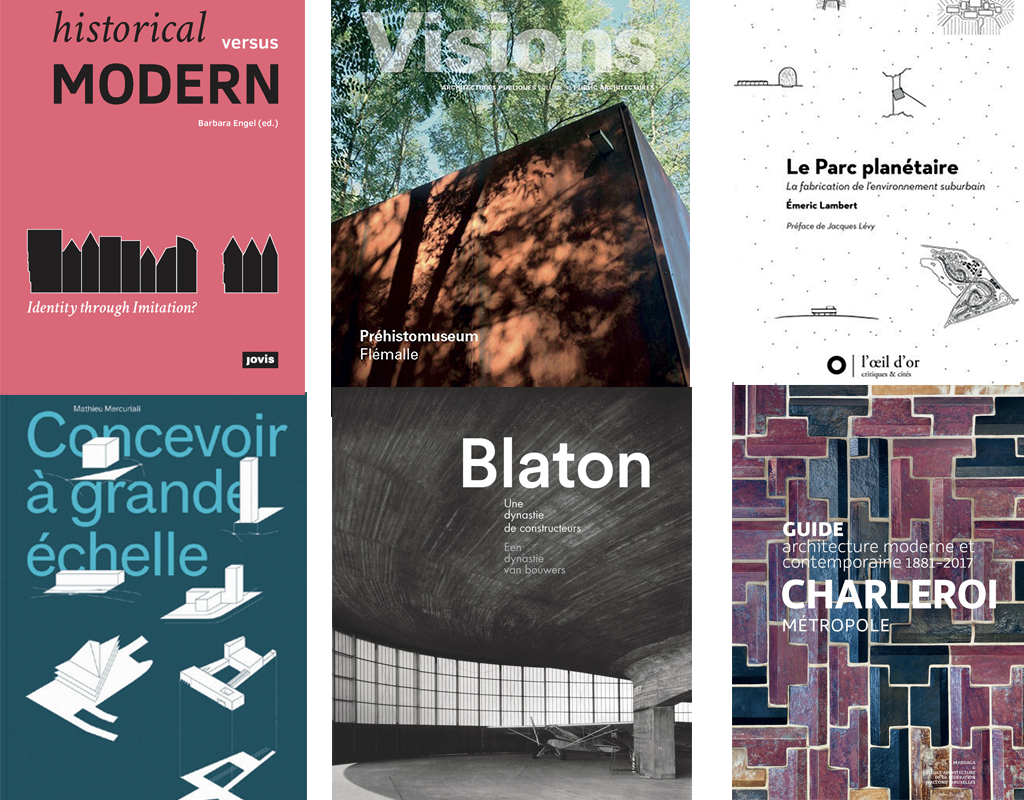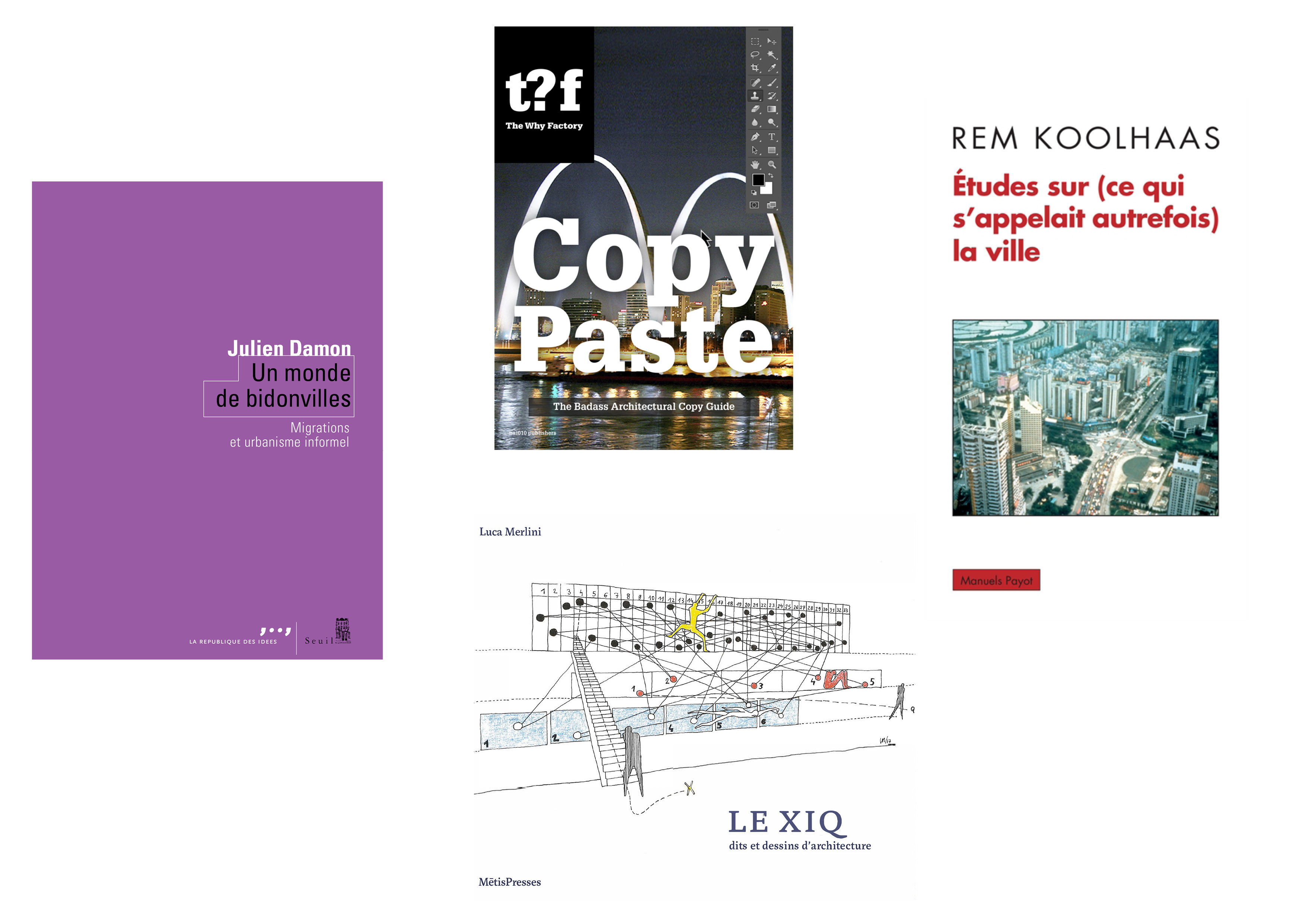AA’s books selection – December 2018
A few days to Christmas, find some gifts inspirations in AA’s books selection!

La matérialité de l’architecture.
Antoine Picon, Éditions Parenthèses
March 2018, 16,5 x 24 cm, 144 p., illus., 22 €
Is architecture overstated? It scarcely whispers to the average listener. Glaringly loud for specialists, it remains virtually inaudible for others. Antoine Picon tells a short story of architecture offering scholarly insights. He makes sure to distance himself from the postmodern goals that consider architecture to be an art form composed to address the desire of architects, who cross swords with “the blind obstinacy of matter”, to express themselves effectively. This is therefore a important essay for anyone who touches on the “material aspect” of architecture and searches for an “ornament” that cannot be laid claim to without dishonouring modern and contemporary thinking
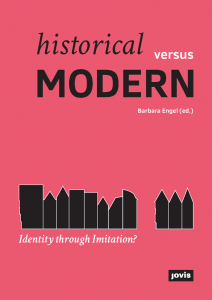
Historical versus Modern: Identity through Imitation?
Barbara Engel (dir.), Jovis,
February 2018, 17 x 24 cm, 224 p., illus., 29,95 €
Words such as restoration, reconstruction and pastiche can frighten critics. Yet the work edited by Barbara Engel presents different cases in which “the identity” of a city or region is manipulated for urban and architectural purposes. From the recent reconstruction of the historic centre of Frankfurt to the “antiquisation” of Skopje, including the fake souks of Dubai and the new old towns of China, the book looks at the question in an encyclopaedic, scientific and disinterested manner.

Concevoir à grande échelle
Mathieu Mercuriali, Éditions B42
March 2018, 19 x 26,9 cm, 192 p.,illus., 24 €
The fantasy of grandeur! Utopian and dystopian megastructures first. Bigness, business and hyper projects to follow. In this book, Mathieu Mercuriali, architect and urban planner, studies several Paris projects, from the Samaritaine to Maine-Montparnasse, not to mention the Macdonald warehouse, elaborating on his “largescale” ambitions, including the transformation of Gare de Lyon into a “mega-project”.
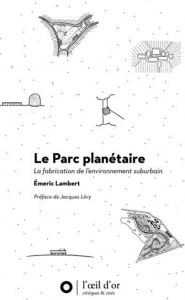
Le Parc planétaire, la fabrication de l’environnement suburbain
Émeric Lambert, l’oeil d’or
January 2018, 13 x 21 cm, 272 p., 18 €
Suburbs are the subject of all manners of criticism. Once again, the historiography turns its back on the arrival of new cities. In this quagmire of remarks, Émeric Lambert brings some necessary insight on “the creation of the suburban environment”. Taking the example of Sénart, a few kilometres to the southeast of Paris, he illustrates how the utopia results in paperwork, planning and building opportunism.
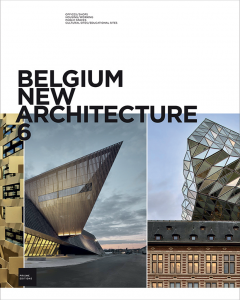
Belgium New Architecture 6
Ouvrage collectif, Prisme Éditions, Bruxelles
December 2016, 24 x 30 cm, 288 p., illus., 49,50 €
One book, five years of Belgian architecture. 288 pages of excellence and optimism. With the exception of the introductory comments by Pierre Loze, art historian, for whom “the shrinking of public resources, the calcification of identity issues and retreat to cultural baselines that we can see among our governing class, doubtless accentuates the current fault line between the progressive and constructive thinking of a new generation and the hard reality that the future may have in store for us all”. Belgium into darkness…

Guide d’architecture moderne et contemporaine. 1881-2017. Charleroi Métropole
Ouvrage collectif, Mardaga, avec la Cellule
Architecture de la Fédération Wallonie-Bruxelles
2017, 24 x 17 cm, 368 p., illus., 35 €
Follow the guide! This way to Charleroi. That way to Tournai. With these two guides, the Architecture Unit of the Wallonia-Brussels Federation and publishing house Mardaga are continuing their significant efforts launched with other towns, in particular Liège and Mons, to catalogue and classify remarkable modern and contemporary architectures. Famous buildings and iconic monuments are presented in these generously illustrated pages next to photographs and plans of sometimes little-known examples of domestic architecture.

Préhistomuseum
Ouvrage collectif, Cellule Architecture
de la Fédération Wallonie-Bruxelles
2017, 17,2 x 21,5 cm, 112 p., illus., 19 €
The Architecture Unit of the Wallonia-Brussels Federation publishes monographs on public facilities. Entitled Visions, Architectures publiques, this collection offers different insights into a single building: a photographer, an author, a critic and also users are invited to express their opinions. The latest volume to date is dedicated to the Prehistomuseum in Flémalle designed by L’Atelier d’architecture aiud (Gil Honoré), landscape architect Mathilde Sauvillers and scenographer Pascal Payeur. An opportunity to find out more about this delicate work including an archaeo-restaurant and mammoth playground.

Blaton, une dynastie de constructeurs
Ouvrage collectif, éditions AAM, Bruxelles
February 2018, 30,5 Å~ 23 cm, 288 p., illus., 35 €
Architecture viewed through the lens of a building company. Five years ago, Blaton delivered three truckfuls of boxes to the Archives of Modern Architecture (AAM) including plans by Victor Horta, Henry Van de Velde, Victor Bourgeois, Michel Polak, Paul-Amaury Michel and Gustave Magnel. In 2018, a book by AAM drafted using this providential archive celebrates the 150th anniversary of the group which was a pioneer of prestressed concrete.
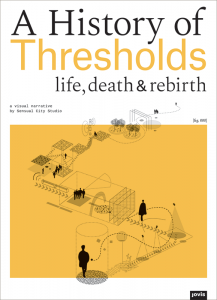
A History of Thresholds. Life, Death & Rebirth
Sensual City Studio, Jovis, Berlin
June 2018, 15 x 21 cm, 184 p., illus., 32 €
Architectural features, such as doors, windows and roofs, are the subject of some very interesting research. The 14th Venice Architecture Biennale, curated by Rem Koolhaas, was an illustration of this. In relation to this, Sensual City Studio (Pauline Marchetti, Jacques Ferrier, Philippe Simay, Estefania Mompean), published by Éditions Jovis, offers a “visual narrative” (in English in this French book) of the History of Thresholds. “Crossing a threshold is often the subject of a theatrical and architectural dramaturgy”, say the authors. From a collection of images and quotations (Hannah Arendt, Peter Sloterdijk, Walter Benjamin and Gaston Bachelard, always), the studio introduces the idea of a narrative and experiences that are severely lacking in architecture.

Lieux infinis. Construire des bâtiments ou des lieux ?
Ouvrage collectif, éditions B42, Paris
May 2018, 16 x 23 cm, 356 p., illus., 28 €
Have architects lost as much power as they claim? This contemporary lament tends to be contested by the French Pavilion of the 16th Venice Architecture Biennale, created by a generation, in the footsteps of Patrick Bouchain, that defends the creation of “infinite places”. The catalogue published for the occasion conveys the message of the curators – Encore Heureux – but also anthropologists, sociologists, and journalists, offering a variety of viewpoints to provide food for thought on “the social role of architecture and the architect”.
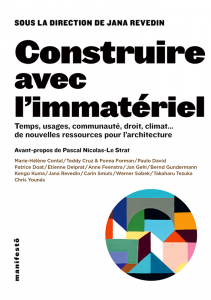
Construire avec l’immatériel
Sous la direction de Jana Revedin, éditions Alternatives, Paris
May 2018, 14 x 19 cm, 176 p., 17 €
Jana Revedin continues her efforts to promote a different and exemplary kind of architecture through the Global Award for Sustainable Architecture. This new work, published by Éditions Alternatives, is given over to the various award winners, who now form a “community”. The publication has risen to the challenge of demonstrating that architecture is also a discipline manipulating “intangible” resources such as time, climate, knowledge, traditions and even law.

L’Hypothèse collaborative
Ouvrage collectif, éditions Hyperville, Paris
May 2018, 20 x 12,5 cm, 288 p., illus., 25 €
Are collectives the new pet theme in architecture and regional development? There is not a single urban project, these days, that does not have “participative”, space provided by a “collective”. The Collaborative Theory, the new book launched by the publishing house Hyperville offers several “conversations” about the subject. The dialogue is fascinating, educational, forward-looking, critical and sometimes a little circumspect. Transitional urban development is now manipulated politically to create “symbolic value”, but also quick “financial value”. “It can be the vector for a more inclusive, more open and fairer city, or an instrument for urban gentrification, turnover and all things ‘disposable’, for place marketing, constructing a smooth modern image that guarantees the success and marketing of real estate products”, says Cécile Diguet, urbanist, with some concern, in the pages of this fascinating book.

